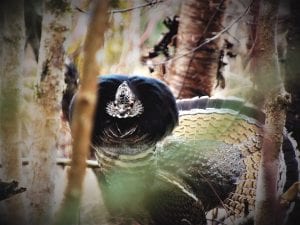Minnesota’s ruffed grouse spring drumming counts were up 57 percent statewide this year compared to last year, according to a survey conducted by the Minnesota Department of Natural Resources.
“The grouse population is nearing its 10-year peak,” said Charlotte Roy, DNR grouse project leader. “Grouse populations tend to rise and fall on a decadelong cycle and counts this year are typical of what we expect as the population nears the peak.”
Drumming is a low sound produced by males as they beat their wings rapidly and in increasing frequency to signal the location of their territory. Drumming displays also attract females that are ready to begin nesting. Ruffed grouse populations are surveyed by counting the number of male ruffed grouse heard drumming on established routes throughout the state’s forested regions.
Drumming counts are an indicator of the ruffed grouse breeding population.
The number of birds present during the fall hunting season also depends upon nesting success and chick survival during the spring and summer. For the past 68 years, DNR biologists have monitored ruffed grouse populations. This year, DNR staff and cooperators from 15 organizations surveyed 122 routes across the state.
The 2017 survey results for ruffed grouse were 2.1 drums per stop statewide. The averages during 2013, 2014, 2015 and 2016 were 0.9 and 1.1 and 1.1 and 1.3, respectively. Counts vary from about 0.6 drums per stop during years of low grouse abundance to about 2.0 during years of high abundance.
Results this year follow an increase from 2015 to 2016. In the northeast survey region, which is the core of Minnesota’s grouse range, counts were 2.5 drums per stop; in the northwest there were 1.6 drums per stop; in the central hardwoods, 0.9 drums per stop; and in the southeast, 0.8 drums per stop. Statewide, drums per stop were as high as during the last peak in drumming in 2009, but have not yet reached previous peak levels in all regions.
Hunting prospects
For grouse hunters, the large increase in drumming counts this year is sure to be a signal of good times ahead during the fall season, said Ted Dick, DNR forest game bird coordinator.
“We’re excited about the way things are looking,” he said. “We have more good grouse habitat than anywhere in the lower 48 states.”
Grouse hunters have a wealth of public land from which to choose. There are 49 ruffed grouse management areas across northern and central Minnesota that provide destinations for hunters in areas with good potential for producing grouse. There are 528 wildlife management areas in the ruffed grouse range that cover nearly 1 million acres and 600 miles of hunter walking trails. State forests, two national forests and county forest lands also offer many additional acres of public land for hunting.
“Grouse hunting need not be complicated and it’s another way to experience the outdoors in the fall,” Dick said. “Combine all that with our grouse numbers nearing peak and this is shaping up to be a great year to try grouse hunting for those who haven’t.”



Loading Comments